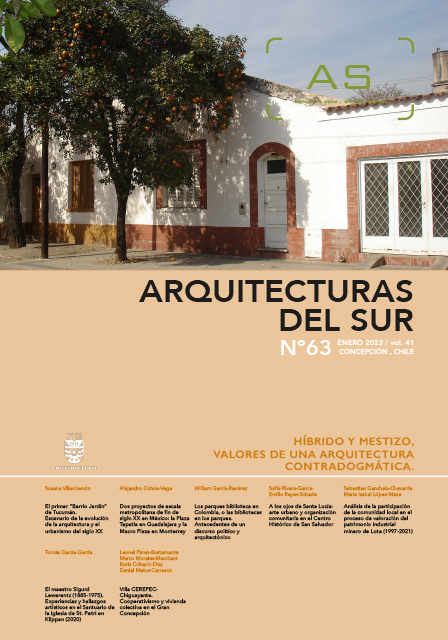Tucumán’s first “Garden Neighborhood”. The setting for the evolution of twentieth-century architecture and urbanism
DOI:
https://doi.org/10.22320/07196466.2023.41.063.01Keywords:
Tucumán, garden city, californian chalet, modern urbanism, modern architectureAbstract
This article addresses the study of the first neighborhood designed and financed by the Caja Popular de Ahorros, called Barrio Jardín and located in the city of San Miguel de Tucumán. Its recipients were the province's salespeople and industrial workers, who were given access to mortgages. This was the first response from the provincial entity for a low-income sector, to face the lack of housing. The housing development, inspired by the English garden city structure, transformed and applied to the garden suburb concept, had its architectural expression in the Californian chalet. The three extensions it underwent in subsequent decades followed the trends of the Modern Movement, both in terms of urban layout and its architecture. The research adopted a qualitative methodology, viewing the problem from a historical perspective. Although work began in the context of Juan Domingo Perón's first government (1946-1952), the extensions were made between 1962 and 1973, in other political and economic circumstances. The unit of analysis is limited to the first garden neighborhood of San Miguel de Tucumán, with its different stages of expansion, but the timeline covers the 1940s, 1960s, and 1970s. The goal of this article was to look through the urban–architectural lines applied in the different stages of the Garden Neighborhood's design, where urban land occupation and architecture were the product of the prevailing principles at their times.
Downloads
References
ÁLVAREZ, B. y CORREA DEZA, M. F. (2013). La movilidad social en Tucumán, Argentina, 1869-1895. América Latina en la historia económica, 20(1), 126-157. Recuperado de: http://www.scielo.org.mx/scielo.php?script=sci_arttext&pid=S1405-22532013000100005&lng=es&tlng=es.
BAER, L. y J. DUARTE (2011). Construcción de vivienda popular y regulación del mercado inmobiliario. La política de vivienda del “primer peronismo” en la metrópolis de Buenos Aires. Realidad Económica, (263), Buenos Aires: Instituto Argentino para el Desarrollo Económico (IADE). Recuperado de: http://www.iade.org.ar/system/files/ediciones/realidad_economica_263.pdf
BALLENT, A. (2005). Las huellas de la política. Viviendas, ciudad, peronismo en Buenos Aires, 1943-1955. Buenos Aires: Universidad Nacional de Quilmes.
BALLENT, A. y LIERNUR, J. (2014). La casa y la multitud. Vivienda, política y cultura en la Argentina moderna. Buenos Aires: Fondo de Cultura Económica.
BENÉVOLO, L. (1996). Historia de la Arquitectura moderna. Barcelona: Gustavo Gili.
BLANCO, G. (2019). El gobierno desarrollista de Arturo Frondizi analizado desde la óptica del estructuralismo. Universidad Nacional de La Pampa: Portal de Revistas Académicas y Científicas de la UNLPam. Recuperado de: https://core.ac.uk/download/235048125.pdf
BLASCO, J. A. (2016). El descontento frente a la ciudad industrial: reformismo social y “ciudad jardín” en España, 1900-1923. Revista de Historia Industrial, (37). Recuperado de: http://urban-networks.blogspot.com/2016/02/el-modelo-original-de-la-ciudad-jardin.html
CHIARELLO, A. L. (2015). El tipo chalet californiano en la arquitectura doméstica del noroeste argentino. Tucumán y Salta, 1930-1950. Revista de Historia Americana y Argentina, 50(2), 185–214. Mendoza: Universidad Nacional de Cuyo.
COSTA, C. (2020). Arquitectura e infraestructura para el desarrollo en Argentina (1960–1975): 06 un abordaje desde la industria, energía y conexiones territoriales. ARQUISUR Revista, (18), 92-105. Recuperado de: file:///C:/Users/Operador/Downloads/9491-Texto%20del%20art%C3%ADculo-31150-1-10-20201217.pdf
CRAVINO, A. (2016). Historia de la vivienda social. Primera parte: del conventillo a las casas baratas. Vivienda y Ciudad, 3, 7-24. Recuperado de: https://issuu.com/invihabunc/docs/vivienda___ciudad_3
CRAVINO, A. (2020). Historia de la vivienda social. Segunda parte. Vivienda y Ciudad, 7, 250-273. Recuperado de: https://revistas.unc.edu.ar/index.php/ReViyCi/article/view/25397/32290
DEHEZA, M. G. (2015). 100 años en la vida de los tucumanos. 1915-2015. Tucumán: Editorial Tropa.
GARGANTINI, D. M. (2012). Revisión histórica de políticas sociales. Recuperado de: https://blog.ucc.edu.ar/ssh/files/2012/03/Revisi%C3%B3n-hist%C3%B3rica-de-pol%C3%ADticas-habitacionales_Gargantini.pdf
GÓMEZ, J. L. (2015). Un país para construir. Las políticas del Banco Hipotecario Nacional durante el primer peronismo, 1946-1955. Ponencia presentada en el XI Congreso Brasileiro de História Econômica. Recuperado de: http://www.abphe.org.br/arquivos/2015_juan_lucas_gomez_un-pais-por-construir-las-politicas-del-banco-hipotecario-nacional-durante-el-primer-peronismo-1946_1955.pdf
JÁUREGUI, A. (2018). Planificación económica y autoritarismo en la “Revolución Argentina” (1966-1971). Quinto Sol, 22(1), 1-28. Recuperado de: https://cerac.unlpam.edu.ar/index.php/quintosol/article/view/1840/2470
LARROSA, L. (1947). El problema de la vivienda y el estado. Buenos Aires: Universidad de Buenos Aires, Facultad de Ciencias Económicas. Recuperado de: http://bibliotecadigital.econ.uba.ar/download/tesis/1501-0428_LarrosaL.pdf
MANSILLA, S. L. (1993-1994). Del "conventillo" a la "villa de emergencia": segregación residencial y migraciones intraurbanas en San Miguel de Tucumán. Revista de Geografía, XXVII-XXVIII, 73-81.
MONCLÚS, J. y DIEZ, C. (2015). El legado del Movimiento Moderno. Conjuntos de vivienda masiva en ciudades europeas del Oeste y del Este. No tan diferentes…. –rita. Revista indexada de textos académicos, (3), 88-97. DOI:10.24192/2386-7027(2015) (v3) (04)
MONTIEL ÁLVAREZ, T. (2015). Ebenezer Howard y la Ciudad Jardín. ArtyHum. Revista digital de Artes y Humanidades, 9, 118-123. Recuperado de: https://www.aacademica.org/teresa.montiel.alvarez/15.pdf
PÁEZ DE LA TORRE, C. (1987). Historia de Tucumán. Buenos Aires: Plus Ultra.
PATERLINI, O. (2010). La centralidad urbana histórica en San Miguel de Tucumán. En Gutman, M. (Coord.) Argentina: persistencia y diversificación, contrastes e imaginarios en las centralidades urbanas, Centralidades, Vol. 3 (pp. 55-96). Quito: OLACCHI.
TÍO VALLEJO, G. y WILDE, A. (2017). Historia del Municipio de San Miguel de Tucumán. Buenos Aires: Ediciones Imago Mundi.
Downloads
Published
How to Cite
Issue
Section
License
Copyright (c) 2023 Susana Villavicencio

This work is licensed under a Creative Commons Attribution-ShareAlike 4.0 International License.
The content of the articles published in each issue of Arquitecturas del Sur is the sole responsibility of the authors and does not necessarily represent the opinion of University of the Bío-Bío.
The authors will maintain their copyright; however, they will guarantee the journal the right to first publication and dissemination of their work. The publication of the article in Arquitecturas del Sur will be subject to the Creative Commons International license (CC BY-SA) that allows others to adapt: remix, transform and build on the material for any purpose, even commercially; share: copy and redistribute the material in any medium or format, as long as the authorship and first publication in this journal are acknowledged by citing them correctly, and their new contributions are under a license with the same terms.














 Programa de Información Científica/Concurso Fondos de Publicación de Revistas Científicas 2018/ Proyecto Mejoramiento de Visibilidad de Revistas UBB (Código:FP180007)
Programa de Información Científica/Concurso Fondos de Publicación de Revistas Científicas 2018/ Proyecto Mejoramiento de Visibilidad de Revistas UBB (Código:FP180007) 
